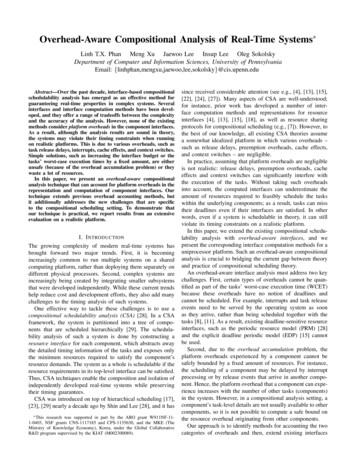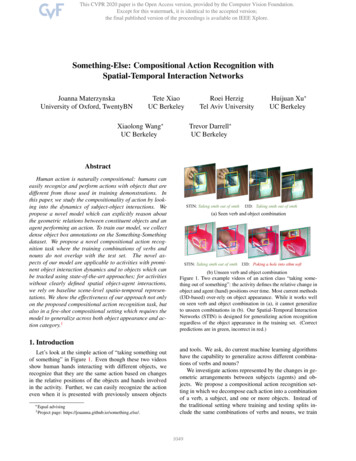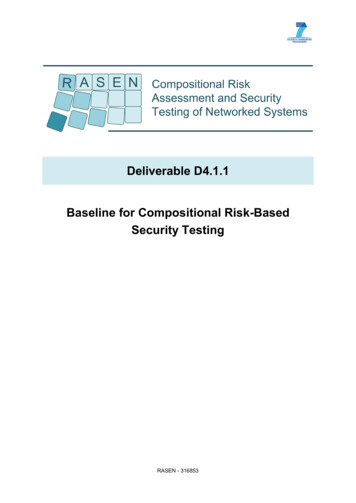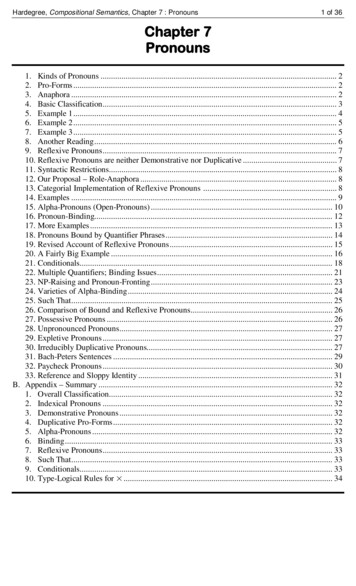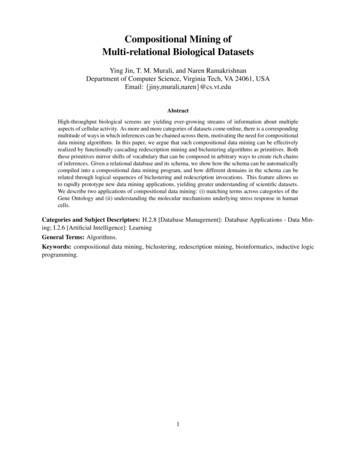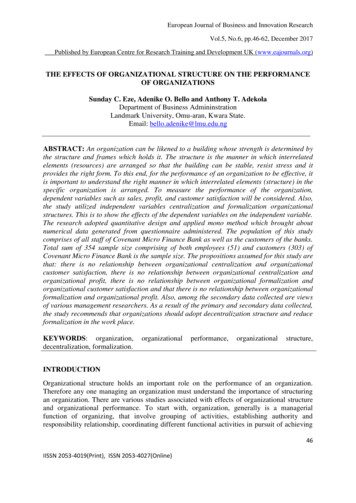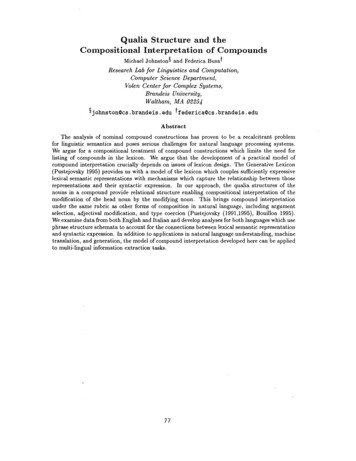
Transcription
Qualia Structure and theCompositional Interpretation of CompoundsMichael Johnston§ and Federica BusatResearch Lab for Linguistics and Computation,Computer Science Department,Volen Center for Complex Systems,Brandeis University,Waltham, MA 02254§johnston@cs .brandeis. edu tfederica cs, brandeis, eduAbstractThe analysis of nominal compound constructions has proven to be a recalcitrant problemfor linguistic semantics and poses serious challenges for natural language processing systems.We argue for a compositional treatment of compound constructions which limits the need forlisting of compounds in the lexicon. We argue that the development of a practical model ofcompound interpretation crucially depends on issues of lexicon design. The Generative Lexicon(Pustejovsky 1995) provides us with a model of the lexicon which couples sufficiently expressivelexical semantic representations with mechanisms which capture the relationship between thoserepresentations and their syntactic expression. In our approach, the qualia structures of thenouns in a compound provide relational structure enabling compositional interpretation of themodification of the head noun by the modifying noun. This brings compound interpretationunder the same rubric as other forms of composition in natural language, including argumentselection, adjectival modification, and type coercion (Pustejovsky (1991,1995), Bouillon 1995).We examine data from both English and Italian and develop analyses for both languages which usephrase structure schemata to account for the connections between lexical semantic representationand syntactic expression. In addition to applications in natural language understanding, machinetranslation, and generation, the model of compound interpretation developed here can be appliedto multi-lingual information extraction tasks.77
1IntroductionThe analysis of nominal compound constructions has proven to be a recalcitrant problem for linguistic semantics (Bergsten 1911, Jespersen 1942, Marchand 1970, Lees 1970, Downing 1977, Levi 1978,Warren 1987), and their analysis has presented a serious challenge for natural language processingsystems (Finin 1980, McDonald 1982, Isabelle 1984, Alshawi 1987, Hobbs et al 1993, Bouillon etal 1992, Jones 1995, Johnston, Boguraev, and Pustejovsky 1995). In this paper, we argue thatcomposition in compound constructions involves specification of the arguments of predicate structures within the qualia structure of the head noun. In essence, the qualia structure provides the'glue' which links together the semantic contributions of modifying nouns and the head noun inthe compound. This approach has significant advantages over approaches which introduce abstractrelations to describe the form of modification involved (Levi 1978, Jones 1995), in that it assimilatesthe composition of complex nominals to other compositional processes of natural language. Thepredicates in the qualia are not there just to account for compounds but also to account for a widevariety of forms of composition and interpretation including argument selection, adjectival modification, and type coercion (Pustejovsky (1991,1995), Bouillon 1995). In order to account for theavailability of compounds and other complex nominals we utilize phrase structure schemata whichcapture the different ways in which head nouns and modifying nouns can compose. We develop andillustrate our approach using data from English and Italian. Consider the correspondences belowin (1).(1)a.d.bread knifecoltello d apanelemon juicesucco d . ilimoneb.e.wine glassbicchiere d .avinoglass doorporta a vetric.f.bullet holeforo d pallottolasilicon breastseni siliconeEnglish compounds consist of sequences of nouns. The final noun is the head and the othersare modifiers. Italian, on the other hand, generally avoids compounds. Most of the compoundsthat are possible involve an underived verb (e.g. portadocumenti (document holder), segnalibro(bookmark), spaventapasseri (scarecrow), etc.) 1 In place of the compound construction, Italianutilizes post-modifying prepositional phrases to construct complex nominals.Consider first the forms in (la) and (lb). In both of these forms the modifying noun providesinformation regarding the purpose or function of object described by the head noun. In (la), breadspecifies the object which the knife is typically used to cut. In (lb), wine specifies the substancethat the glass is used to hold. For forms in which the modifier specifies some aspect of the purposeof the head, the preposition in the Italian form generally is da.In (lc) and (ld), the modifier relates to the origin of the object described by the head noun,how it was brought about. A bullet hole is a hole which was brought about by the passage of abullet, and lemon juice is juice that is brought about by squeezing a lemon. For forms in which themodifier specifies some aspect of the origin of the head, the appropriate preposition for the Italianform appears to be di.In (le) and (lf), the modifier relates to the constitution of the object described by the headnoun, what it is made of. A glass door is a door made of glass, while a silicon breast is a breast,at least partially, composed of silicon. For forms in which the modifier specifies the constitution ofthe head, the appropriate preposition in Italian is a.In English, the form of the semantic relation that holds between the modifying noun and the1See Beard(1996) for an interesting account of why Italian does not utilize the compound construction.78
head noun is unspecified and left implicit, while in the corresponding Italian complex nominals,it is partially specified by the preposition which introduces the modifying noun. This differencebetween English and Italian is representative of a more general difference in structure betweenGermanic languages and Romance languages. Complex nominal expressions in Germanic languagesfrequently involve compounding while complex nominals in Romance languages use post-modifyingprepositional phrases. One motivation for examination of parallel data from English and Italianis that it can reveal the otherwise implicit relation between the elements of an English compound.This difference in the internal structure of nominals has important consequences for multilinguallanguage processing. For example, in order to translate English complex nominals into Italian youneed to determine the nature of the semantic relation in the compound in order to determine thepreposition to use in the Italian form. We return to applications of this work later in Section 7.Our analysis of compounds in English and complex nominals in Italian utilizes the representationalframework of the Generative Lexicon (GL) (Pustejovsky 1991,1995). The next section provides abrief sketch of this approach.2The Generative LexiconFor the purposes of this paper, we will simplify the representational structure of a GL lexical entryto include four levels of representation: type structure, argument structure, event structure (forverbs), and qualia structure. The latter in turn expresses four aspects of the meaning of the lexicalitem: FORMAL,CONSTITUTIVE, TELIC, and AGENTIVE. These lexical entries are encoded usingtyped feature structures. The basic layout of the lexical entries we employ is given in (2).TYPESTRARGSTR(2) ARG]L thetypeof aJ I D-AR61 other a r g u m e n t s in the qualia]LJEVENTSTR /El events in t h e qualia/L" FORMALQUALIAffi isa-relationCONSTITUTIVE parts o fTELIC purl ose of c AGENTIVE hOWOl is brought a b o u tffiGiven this model of lexical representation a noun such as knife has the entry in (3). Thepredicates in the qualia specify the definitional properties of knife. Participants in these predicatesother than the knife itself are listed as default arguments (D-AR I, D-ARC2, and D-ARG3) in79
ARGSTR.knifeTYPESTR ARG1 "D-ARG1D-ARG2ARGSTRQUALIAD-E1 transitionD-E2 [ ]processFORMAL []CONSTITUTIVE JLkmmaa2 (3)[]artifact tool] [ -]physobj" TELIC cut act ({blade,handle,.)[ ] , [], [ ] )AGENTIVE make act(IX], E], [ ] )Representations such as that in (3) are intended to be the values of a C O N T E N T attributewhich specifies the semantic content of a lexical item. All of the representations for single wordsand complex nominals throughout the rest of the paper consist only of the value of C O N T E N T .The phrase structure schemata presented contain full lexical entries which have a C O N T E N Tattribute as well as an O R T H and a D T R S attribute.In the following three sections, we will show how the free classes of compounds considered sofar can be treated as instances of telic, agentive, and constitutive qualia modification respectively.3TelicQualiaModificationIn order to illustrate our approach, we will start with examples such as bread knife (la), in whichthe modifying noun relates to the purpose of the head noun. The preferred interpretation of thiscompound is that it is a knife which is used to cut bread. The fact that a knife is an object whoseinherent purpose is to cut things is encoded by the predicate c u t a c t in the T E L I C role (see (3)above). The function of the modifier bread is to specify the third argument of the cut act relation.The feature structure associated with bread knife will be as in (4). The first default argumentD-ARG1 has been specialized from p h y s o b j to b r e a d and this value is structure-shared with thethird argument position in the c u t a c t predicate.' b r e a d knifeTYPESTRARGSTR (4)QUALIA D-ARG1E]artifact tool] E]breadD-ARG3D-E1 transitionD-E2L jprocessARGI FORMAL []CONSTITUTIVE {blade,handle,.}TELIC cut act( [ ], [ ], [ ], E])ACENTIVE make act(IX], E], [ ] )In the GL representation, all of the participants which show up in the predicates in qualia arelisted as default argument parameters in the A R G S T R .In order to account for the availability of compound forms in English, we utilize a family ofphrase structure schemata. These schemata are essentially the same kind of entity as the Imme80
diate Dominance Schemata employed in Head-driven Phrase Structure Grammar (Pollard and Sag1994). They are schemata which license the availability of complex nominals, which we treat asphrasal signs. These schemata are essentially phrase structure rules. Compounds are licensed andinterpreted as part of the process of parsing.The combination of words into compound forms could also be captured using lexical rules(Flickinger 1987, Pollard and Sag 1987). We have chosen to use phrase structure schemata ratherthan lexical rules on the basis of storage considerations. Each lexical rule used for compounds willlicense a great many modifiers for large number of potential heads. If the lexical rules are used ata pre-compilation stage in order to flesh out the lexicon, allowing lexical rules for compounds willresult in a massive increase in the size of the lexicon. For each noun, a huge number of compoundforms will be generated. If you allow lexical rules for compounds to apply at runtime during theparsing process, then the storage problem is avoided, but then they are really not any differentfrom phrase structure schemata.We will show the schemata as rules here. They can also be encoded as single feature structures.The basic structure of the schemata licensing the combination of nouns to form noun compoundsis as in (5).MODIFIERNOUNHEAD : COMPOUND(5)DTRS I HEAD --The schemata differ with respect to the constraints placed on the C O N T E N T values and the wayin which the CONTENT v a l u e s of the head and the modifier are composed to generate the CO N T E N Tfor the compound as a whole. The availability of compound forms such as bread knife, where themodifier specifies an argument in the TELIC, is accounted for by the schema in (6).MODIFIERNOUNCONTENT HEAD[OONTENT --D]COMPOUND(6)MOD In this notation, the structures describing semantic types are the values of an attribute CONTENT, and ORTH specifies the orthographic form. The C O N T E N T o f the resulting compound isinherited from the head noun. In order to access the argument in the TELIC, the C O N T E N T valueof the modifier is structure-shared with the first default argument in the C O N T E N T of the head.The modifying noun must be of semantic type i n d i v i d u a l and its CO N TEN T value is structureshared with the D-ARG1 in the ARGSTR of the resulting compound. The lexical representationof the compound also contains an attribute DTRS containing a HEAD and a MOD value. Theseare structure-shared with the lexical representations for the head noun and the modifying noun81
respectively.This schema is one of a number which are used to license this kind of modification of defaultarguments. There will also be schemata for modification of other default arguments. The fact thatthe C O N T E N T of the compound always comes from the head noun is captured by having all of thecompound phrase structure schemata, which are themselves implemented as types, all inherit theconstraint specified by the structure-sharing index E].As we saw before, if the modifier specifies an argument in the TELIC qualia role, the prepositionin Italian is da. In order to account for the Italian forms, as in the English case, we utilize phrasestructure schemata. In this case, the schema (7) specifies that the sequence HEAD NOUN, da,MODIFYING NOUN can be interpreted as having the semantic content of the modifying nounspecify one of the arguments within the TELIC role.HEADMODIFIER NOUN[][ORTH [ ]]da [ORTH fl individual] . COMPOUNDfORTH a da flI.t M D The indeterminacy with respect to which argument in the TELIC is coindexed with the modifierin schema (7) is a shorthand representation. A number of phrase structure schemata are used, eachspecifying linking to a different argument position in the TELIC.For Italian, the nature of the modification can alternatively be directly encoded in the lexicalentry for the preposition. The composition could then licensed by a more general phrase structureschema which would work with all of the different prepositions.4A g e n t i v e Qualia M o d i f i c a t i o nCompounds such as bullet hole and lemon juice (1 c,d), in which the modifier relates to the originor bringing about of the object described by the head noun, are treated as modification of theAGENTIVE role. In the case of lemon juice, the head juice will have a s q u e e z e a c t as its AGENTIVEand the object squeezed will be listed as a default argument. The function of the modifying nounlemon is to further subtype this argument. This is possible because l e m o n is a subtype of fruit.These English forms will be accounted for by another schema licensing default argument typespecification, like that in (6) above. The resulting representation for lemon juice is as in (8). Thecorresponding forms in Italian utilize the preposition di. The Italian forms are accounted for by aschema like (8), except that the preposition is di and the linkage is to the AGENTIVE qualia role.lemon juiceTYPESTR (8)ARG1 E]liquid]ARGSTR D-ARG1 % I ]lemonD-E1 []transitionQUALIA FORMAL [ ]]AGENTIVE s q u e e z e . a c t ( [ ] , E]' E ] ) ' -J82
5C o n s t i t u t i v e Qualia ModificationAnother common function of modifiers in complex nominals is to specify a subpart of the denotationof the head noun or the material of which it is composed. Examples of this are given in (1 e,f).In our treatment, this involves modification of the CONSTITUTIVE role. The prepositions used inItalian for this: sort of modification are a and al. The modifiers glass and silicon denote materials.When composed with nominals such as door and breast they specify elements of the C O N S T I T U T I V Erole. For example, glass door is represented as in (9). These forms are licensed using further phrasestructure schemata for English and Italian. glassdoorTYPESTR (9)ARGSTR AaG1 [ ]phys obj]ARG2 L J a p e r t u r eJD-ARC1 [';?]individualD - A R G 2 . [ ]ndividualD-E1 2 JtransitionD-E2 [ 3 JtransltionFORMAL hold( E l ' [ ] )QUALIA CONSTITUTIVE {[]glass}TELIC walk through act( [ ], E ] , [ ] )AGENTIVE make.act( [ -], El, E]" [ ] ) The basic pattern established so far is that modification of T E L I C , A G E N T I V E , a n d C O N S T I T U T I V Einvolves da, di, and a, respectively. This is a useful generalization but the correspondence betweenthe different qualia roles and different choices of preposition in Italian is not as clear cut as thissuggests. In the examples of TELIC qualia modification considered so far (1 a,b), the modifyingnoun was always of type i n d i v i d u a l . Matters become more complex when compounds in whichthe modifying noun describes an event are considered. These are addressed in the next section.6Telic Event ModifiersIn some forms where the modifier describes an event, the appropriate preposition in Italian is da,as in the forms in (10), while others the preposition is di, as in the forms in (11).(10)a.(11)a.d.hunting riflefucile d. . acacciadestruction weaponsaxmi d i distruzioneconcentration campcampo d .iconcentramentob.b.e.race carmacchina d acorsacredit cardcarta d creditodivorce procedureprocedura d i divorzioc.c.carving woodlegno d aintagliorest homecasa d riposoIn general, the TELIC u s e o f the preposition di appears to select consistently for modifiers whichdenote events. Even though this does not yet explain the difference between (10) and (11), italready provides us with a restriction on the use of prepositions. In other words da selects forany type, while di is restricted to events. We assume the Vendlerian distinction between activities,states, accomplishments, and achievements. In addition, we adopt a decompositional view of eventstructure, as outlined in Pustejovsky (1991), in which the event structure representation of alexical item makes reference to the configurational properties of subevents and arguments. In83
this framework, which allows us to make fine grained distinctions between event types, we candetermine the selectional properties of di and da, on the basis of the event type of the modifiers.Nominals such as hunting, race, and carving describe activities. Nominals such as destruction,credit, and so on, in (11) above, describe the result of an activity. This distinction arises quiteclearly in the glosses of (10) and (11). Compound forms such as hunting rifle or race car in (10),describe respectively an instrument which is used when hunting, and a vehicle that is driven forthe purpose of racing. Conversely, the reading of the compounds in (11) makes explicit the resultwhich is achieved by using a particular object. In particular ( l l a ) refers to weapons that bringabout destruction; ( l l b ) to a card that brings about a credit, and so on.Unlike the operation which derives bread knife by associating the modifier to an argumentposition in the TELIC role of bread, the compositional operations which involve events producea more complex structure. We argue that compounds where the modifying noun describes anevent, such as those in (10), involve co-composition of the qualia structures of the head and themodifier. The resulting representation has a complex TELIC role with "sub-qualia". In the caseof hunting rifle, the TELIC of rifle, which is fire provides the AGENTIVE within the TELIC of thecompound. The modifier hunting is a process nominal and provides h u n t as the TELIC within theTELIC of the compound. Through the application of phrase structure schemata which constrainthis co-composition, we obtain the representation in (12) for hunting rifle.rifleTYPESTR [ARG1 [ ] rifle] hunting[ D-ARG1 ] h u m a nARGSTR [ D-ARG2[ Llprey [D-E1 p r o c e s s "(12)EVENTSTRLD- 2[. .j process"FORMAL [ ]QUALIA ffiTELIC activityAcpTELIC h u n t ( ] , [ ] , [ ] )AGENTIVE f i r e ( J , [ ], [ ] )The interpretation of the compound form hunting rifle can be glossed as follows:"a rifle which isused in its typical capacity (i.e. firing) for the purpose of performing the activity of hunting." Theassignment of a complex structure to an individual quale is coherent with the general interpretationof qualia structure. Exploiting these recursive properties of event-denoting qualia is not an ad-hocmove to account for the interpretation of complex nominals but is also motivated by the behaviorof agentive nominals and their semantic contribution in context (cf. Busa 1996).The modifying noun in Italian complex nominals with the preposition di describes the resultthat is achieved by performing the particular function associated with the head noun. The nominaldestruction, in ( l l a ) , unlike the event nouns hunting and race which denote activities, is the nominalization of the transitional event denoted by the verb destroy. The two subevents, namely theprocess and the resulting state, in the event structure representation of the verb, are encoded inthe nominalized form as separate events in the AGENTIVE and FORMAL roles, and they are relatedby the relation of temporal precedence o . As argued in Pustejovsky (1995) this representationgives rise to the polysemous behavior of the nominal. It alternates between a p r o c e s s a n d a resultinterpretation. In destruction weapon, the embedded AGENTIVE in the TELIC is again the TELIC ofthe head weapon, and the embedded TELIC is the resulting state from the semantics of destruction.84
!The resultingis a p r o c e s s - r e s u l t - l c p , as shown in (13).TELIC"destruction weaponTYPESTR ARG1 E ] w e a p o n ]D-ARQ1 [7"]individual"D-ARG2 ARGSTR (13)FORMALQUALIA humanD-E1 2 :stateD-E3 I j:processTELICAGENTIVE X["process-result-lcp [FORM destruction result([ ,[ ])LAGENTIVE f i r e ( , [ ] , E]) .The analysis of A G E N T I V E modification is also more complex. In addition to di, della is alsofound for subtyping of arguments in the A G E N T I V E . In other cases, such as morte da annegamento,death from drowning and bruciatura da sole, sun burn, the preposition is da. This preposition dahas a different meaning from the one associated with the TELIC. It corresponds to the Englishpreposition from and it is interpreted as introducing an experiencing relation. It is found in caseswhere the head noun is an event and the modifier introduces the causal factor which brought aboutthat event. We turn now to consider some of the applications of this work in more detail.7ApplicationsThe analysis of complex nominal constructions presented in this paper has a range of importantapplications in natural language processing. Complex nominals play an important role in theencapsulation and expression of nominal concepts and are frequent in a wide variety of types oftexts. Therefore, the ability to handle complex nominals is essential for parsing and generationsystems for either English or Italian. It is important to note that systems utilizing compositionalapparatus for the analysis of complex nominals need not treat all compounds compositionally. Theoptimal arrangement will be to list frequent and idiosyncratic compound forms in the lexicon anduse the compositional apparatus for forms which are not listed, or in instances when the listedinterpretation is ruled out by context. We would also like to point out that we do not expect todevelop an analysis which will handle all and every compound form. Our target is to have anaccount which will handle the majority of productive compounding patterns. Another importantuse of the compositional apparatus described here is in lexical acquisition of compound forms.This machinery can be used to indicate potential interpretations for compounds. A human editorcan then select the appropriate interpretation from the candidate set and add have the compoundadded to the lexicon.Given the range of different semantic relations that can hold between the elements of a complexnominal, they are frequently ambiguous. English compounds are worse than Italian post-modifiedforms in this respect, since in Italian the preposition gives at least some indication of the relationinvolved. The approach described in this paper constrains the interpretation of complex nominalsusing the type system. For example, the schema in (6), which accounts for bread knife, requires themodifying noun to be typed as i n d i v i d u a l . This limits the set of potential modifiers to those typedas i n d i v i d u a l . Since the content of the modifier is structure-shared with an argument position85
within the TELIC, this set of potential modifiers is further constrained by type constraints imposedby the relation in the TELIC role. The cut act will require the object cut to be a separable object.It could potentially require the cutter to be significantly harder than the object to be cut. Typeconstraints of this kind serve to greatly reduce the degree of ambiguity in a given complex nominal,but it will still generally be the case that more than one interpretation is predicted for a given form.For example, a form like bone knife could be interpreted either as a knife used for cutting bone or aknife made of bone. The approach described here needs to be integrated with further mechanismsand heuristics in order to determine the best guess for complex nominal interpretation in anygiven case. One important class of mechanisms are those which examine the current sententialand discourse context in order to restrict the range of interpretations. For example, if bone knifeappears in a medical text, bone most probably specifies the object to be cut by the knife, while if itshows up in a text concerning prehistoric man, bone most probably refers to the constitution of theknife. One way in which compounds can be further disambiguated is through the incorporation of astatistical model as one of the heuristics employed in determining the appropriate interpretation. Insuch an approach, one could train on a data set comprised of compounds paired with an indicationof the relation holding between the head and the modifier. The resulting model would provide theprobability that a given complex nominal involves a particular kind of modification relation. Inorder to have useful predictive power, it would be best to assign semantic types to the elements of thecomplex nominal and determine the probability that a complex nominal consisting of words of typesA and B involves modification relation C. Given the sparsity of data to support a statistically basedapproach we believe that the way forward in this area is to pursue the integration of a rule-basedapproach with a statistical model. Such integration has already proven effective in the treatmentof sense extension phenomena (Copestake and Briscoe 1995). We leave further investigation of thisintegration for future work.This work also has important consequences for applications in multilingual natural languageprocessing. The most obvious of these is the use of a cross-linguistic approach to complex nominalsin machine translation. Translation of complex nominals from Italian to English will be morestraightforward, since there is a loss of information rather than a gain. It is important to note,however, that not all Italian complex nominals involving post-modification can be translated asnoun-noun compounds in English. For example, forms such as coltello d. .amacellaio (literally, knifeof butcher), in which the modifier is an agent using the object described by the head, does nottranslate as butcher knife. In English, the appropriate nominal construction in this case uses thepossessive: butcher's knife.Translation from English to Italian is substantially more difficult given the difference in explicitness regarding the semantic relation between the head and modifier. In order to generatethe proper o u t p u t in Italian, it is necessary to determine the relation between the elements in theEnglish compound structure and to determine the appropriate preposition in Italian for expressionof that relation. One approach to this task is to use the GL representation language essentially asan interlingua (McDonald 1995). The phrase structure schemata for English are used in order todetermine potential interpretations for a given English compound construction. The most likelyinterpretation from the candidate set is picked on the basis of contextual and statistical models.The CONTENT of the chosen candidate is then matched against the outputs of the various phrasestructure schemata used for Italian. When an appropriate schema is identified it is instantiatedwith lexical items from the Italian lexicon in order to generate the Italian translation. An important feature of this approach is that it utilizes resources which are independently needed foranalysis of the languages involved. Aside from translation, the phrase structure schemata can alsobe used for multi-lingual generation. If a particular concept is encoded in the GL lexical representation language, the language-specific phrase structure schemata can be employed to generate the86
corresponding complex nominal in each language.In addition to the importance of successful translation of complex nominals for full-text machinetranslation, this functionality is useful in itself for applications in multi-lingual information retrievaland information extraction. Since complex nominals are so frequently used to coin terms whichencapsulate important distinguished concepts within a domain, their successful identification andprocessing is an essential element of determination of the topic of a text and the:, provide importanthooks for information retrieval. In a multi-lingual setting, such as information retrieval over theWorld Wide Web, it may be desirable for a search for a complex nominal from one language toyield documents regarding the same concept in other languages. The approach to translation ofcomplex nominals described above enables this fun
The Generative Lexicon (Pustejovsky 1995) provides us with a model of the lexicon which couples sufficiently expressive lexical semantic representations with mechanisms which capture the relationship between those representations and their syntactic expression.


